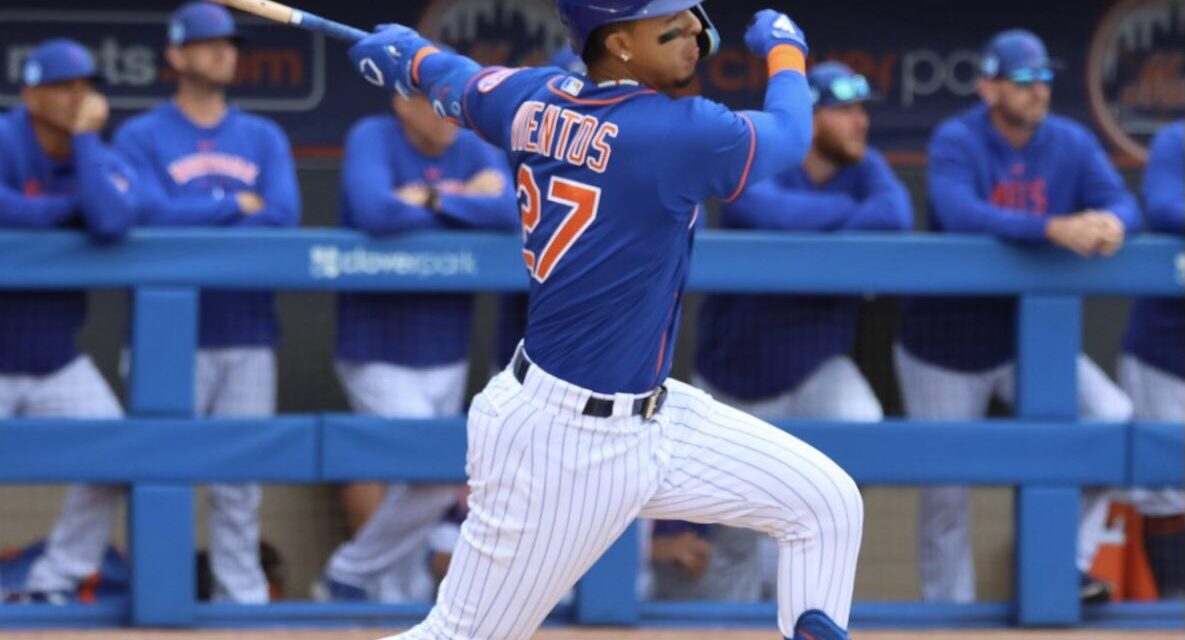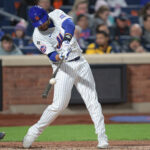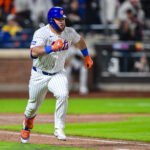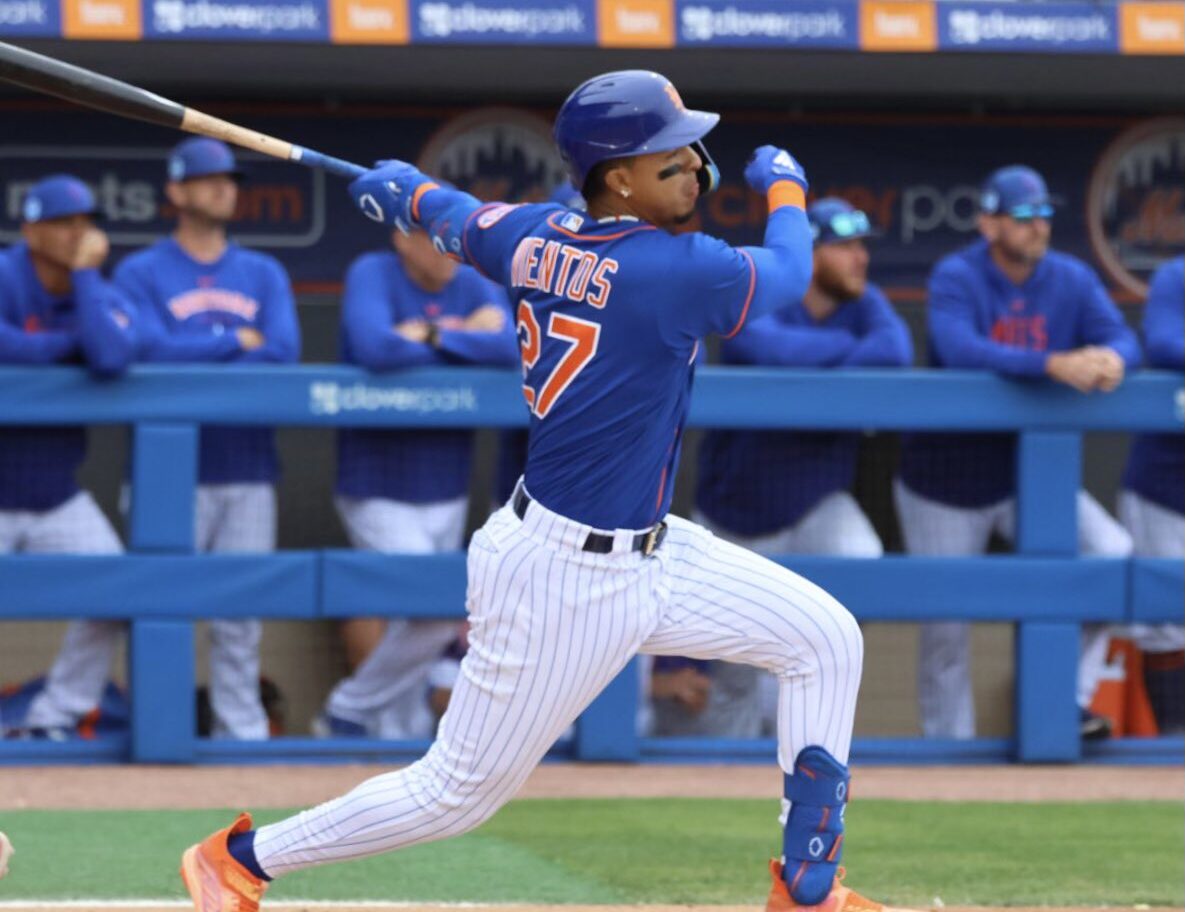
Mark Vientos, Photo by Ed Delany of Metsmerized
The Mets’ struggles of late have been well-documented. A rotation that ranks among baseball’s worst, coupled with an underperforming lineup, has led to four consecutive series losses and a sub-.500 stint through 35 games. This leads a frustrated fan base to demand changes, starting with the most convenient: “Just elevate the prospects!”
In part, this wish makes sense. After all, Brett Baty and Francisco Álvarez are both among the only Mets hitting with any consistentcy lately. It’s natural to want all the kids to play and to inject more youth onto an aging team. The two candidates most often discussed are Mark Vientos and Ronny Mauricio, both of whom got off to hot starts in Triple-A Syracuse this season.
However, just as there is potential upside in elevating these prospects, there are also significant concerns. The situation is not nearly as cut-and-dried as it was with Baty.
All in all, what are the reasons for and against promoting Vientos and Mauricio? Should the Mets bring up one or both of them shortly?
Pro: Power Potential
Through Tuesday’s game, the Mets are tied for 15th in the majors with 40 home runs. They were boosted by the four they hit on Tuesday night, two from Francisco Álvarez and one each from Pete Alonso and Francisco Lindor. However, their power has still been lacking overall this season. In 2022 they finished tied 15th with 171 dingers, or 1.06 per game. That worked out for the team during the 2022 regular season but was also the reason they seemed to go into long offensive funks as a team, a problem that has also plagued them thus far this year.
When a team has players that can hit the ball out at any moment, it’s easier to avoid prolonged collective slumps. Needing to go station to station to score increases the likelihood that those runners will be left on base. That has been the Mets’ problem this season, as their .239/.336/.354/.691 team slash line with runners in scoring position is among baseball’s worst.
Meanwhile, Vientos hit his 11th home run of the season for Syracuse on Tuesday and seems to be in the news with another blast every time you turn around. He is hitting one home run every 10.45 plate appearances; for reference, in Pete Alonso‘s 53-homer rookie season, he hit a home run every 13.1 plate appearances (and is averaging one every 12.2 this year). Vientos wasn’t even this good last year in Triple-A when he hit 24 homers in 401 PA (one every 17.79 PAs).
While Vientos hit just one home run in 41 major league plate appearances last season, that was a small-enough sample size to believe that he needs more time to find his groove at the next level. Baty and Álvarez both look significantly better this year with more consistent playing time than they did in short big-league stints last season. There is reason to believe that Vientos might be able to do the same.
Mauricio, meanwhile, has six home runs in 138 plate appearances, which isn’t earth-shattering (one every 23 PAs) but is buoyed by a .570 slugging percentage and .248 ISO. He hit one homer per 20 PAs in Double-A last year and has increased the strength of his frame by adding bulk and muscle.
While neither will surely light up the majors immediately, the Mets could use whatever power boost they can get. They have two youngsters in Triple-A who could potentially provide it.
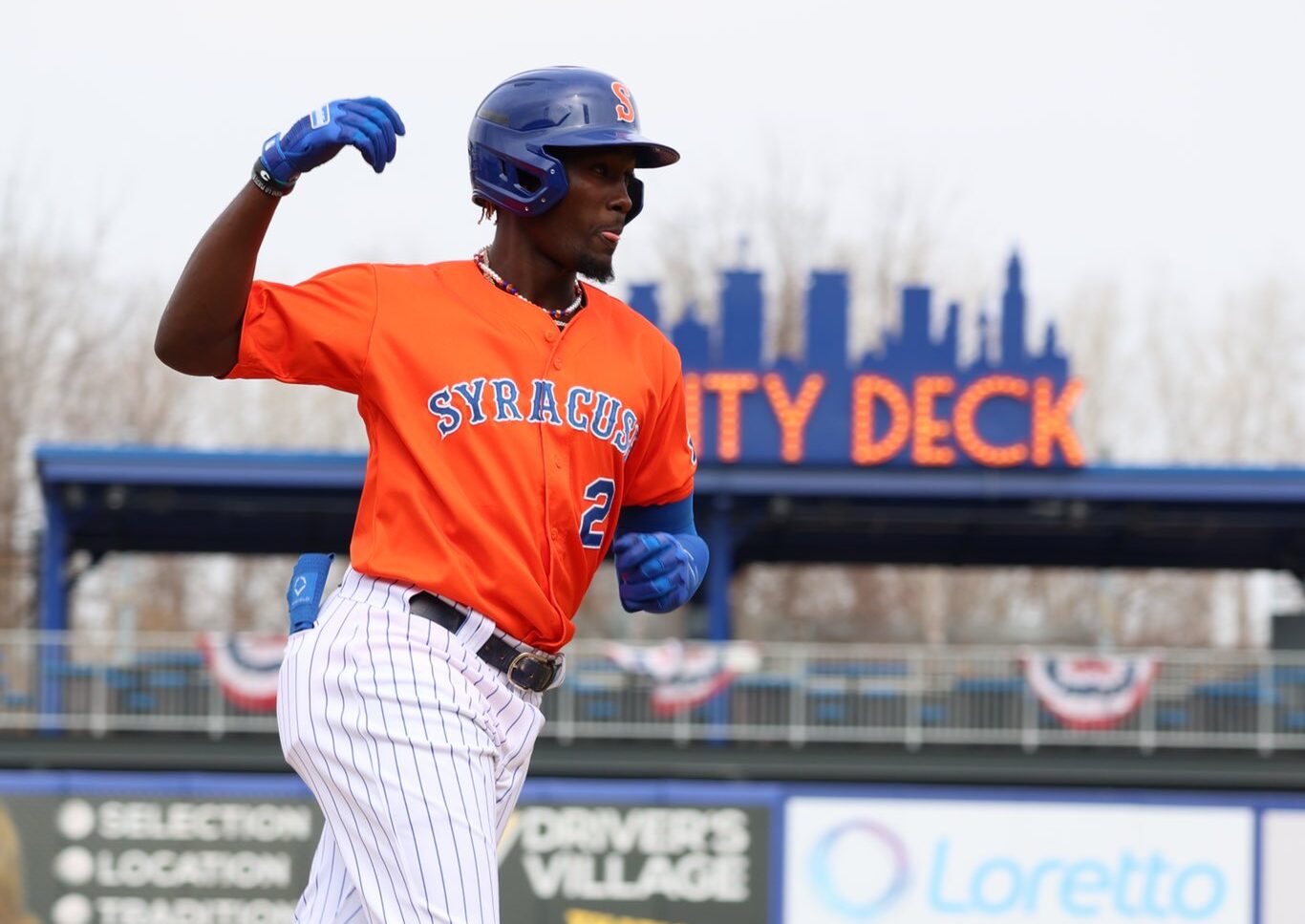
Ronny Mauricio. Photo by Serena Spencer
Con: Roster Crunch
The bigger question becomes who’s going down if the Mets were to bring up Mauricio or Vientos. It’s easy to demand that the team option Luis Guillorme to the minors, but he’s really their only reliable backup middle infielder. If Jeff McNeil is forced to play more significant time in the outfield, the need for Guillorme becomes that much higher. Perhaps Mauricio can take that spot, but he has barely played a handful of games at second base.
There are fans who will push the team to designate Daniel Vogelbach for assignment, but that would be a short-sighted move on the team’s part. It would put all their eggs into the Vientos basket, and if the rookie struggled, the Mets would be left in the lurch. It’s one thing to call up Brett Baty to play third base every day and shift Eduardo Escobar into a backup role, but it’s another to actually let a player go.
Speaking of DFAs, some fans would love to see Escobar be the one to go. However, that would leave the team down another backup middle infielder and one of their only hitters with a history of hitting left-handed pitching. While Vientos has always done so at the minor league level, there’s no guarantee it would transfer to the majors. He did have better splits against southpaws in his time with the Mets last year, batting .222/.364/.444/.808 against them in 18 plate appearances (compared to .111/.158/.111/.269 vs. right-handers). Still, Mauricio would be Escobar’s direct replacement, not Vientos.
There really aren’t too many other options for the pair to replace. That roster crunch is likely one of the primary reasons that Vientos has remained in the minors despite raking.
Pro: Long-Term Evaluation
The Mets’ regular starting lineup at the beginning of the season included four hitters who likely will not be on the team next season. Vogelbach, Escobar, Mark Canha, and Omar Narváez are all either 2024 free agents or in possession of a player option for the offseason. It’s always possible that the Mets would re-sign one or more of these players, but most likely not in starting roles.
As long as the Mets were really going all-in for a championship in 2023, it made sense to keep the veterans in the lineup and hold the youngsters down for another day. But with the team scuffling anyway, there is a decent chance that the Mets will need at least one more prospect to play a significant role on the team to bolster their lineup. For that to happen, they’re going to need a steady diet of at-bats, not intermittent or sparing major-league experience.
Vientos, in particular, is spinning his wheels down in the minors. If he’s going to learn to hit big-league pitching, it will need to come in the big leagues. Yes, he’s generally had a high swing-and-miss profile, but his current 21.2% strikeout rate is not terrible for a slugger. He’s also walking at a 12.1% clip right now, unlike Mauricio’s 4.3%.
It’s possible that Vientos is a Quadruple-A player. The Mets have had plenty of those over the years (including Dom Smith last season). But they need to know what they have, both because Vogelbach is a free agent after the season, and because the team has not been able to pin down a full-time DH since it was instated last year. Vogelbach has shown repeatedly that he is not that. Vientos may have a chance to be.
It’s harder to make that case for Mauricio, as this is his first rodeo at Triple-A. He also has barely any experience outside of shortstop and still struggles with pitch selection. He may well need a full year at Syracuse, at least, before coming to the majors would give the Mets any realistic evaluation of his big-league future. But Vientos, at 23 years old, is really coming to the point where the team needs to know what they have in him.
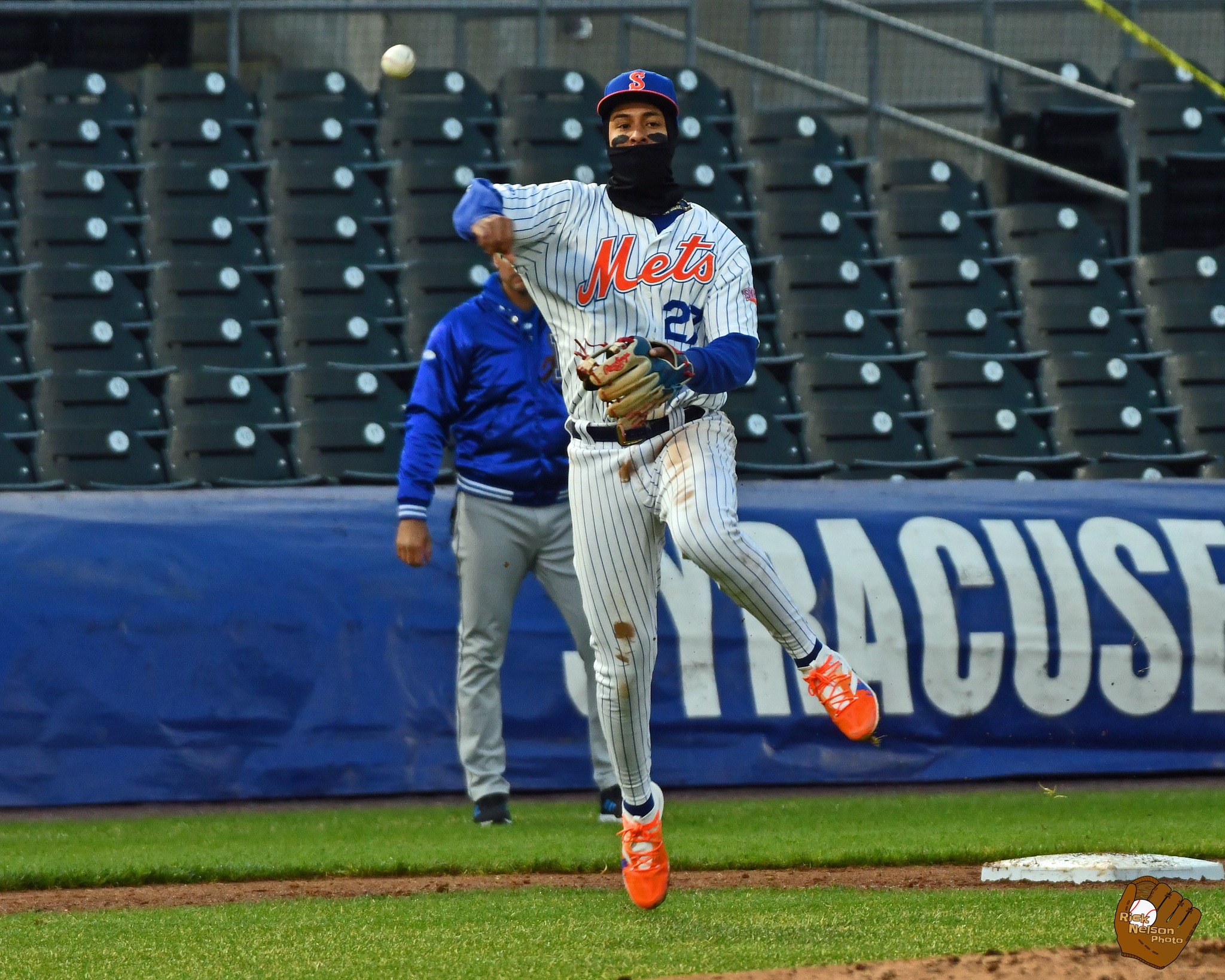
Photo by Rick Nelson
Con: Defensive Limitations
The Mets value Jeff McNeil for his defensive versatility. They have very little of it on the rest of their team, in part because they employ a platoon DH who cannot play the field. That’s one of the reasons they keep Guillorme around despite his hitting limitations and struggles in the field with the absence of the shift.
If Mauricio could play second, short, and the outfield adequately, it might strengthen the case to bring him up despite his rawness at the plate. But he just played his first game at second base less than two weeks ago, and has never played the outfield at the minor league level. Having the athleticism to play a position doesn’t mean a team can just chuck a player out there and make it stick. Mauricio may profile best in center, but it would be a huge jump after playing shortstop during his whole development period to this point.
If Mauricio gets more experience at second and shows a reasonable level of prowess there, perhaps the Mets would consider bringing him up. However, when considering the development also needed in his hitting profile, it’s not necessarily a wise decision to bring him up.
Vientos brings no fielding abilities. The only position at which he would not be an absolute disaster is first base, and Alonso has that spot nailed down. Even if Alonso were willing to DH, pigeonholing Alonso into that spot just so Vientos could play first would be counterproductive. Vientos is truly a DH only. That would short the Mets’ roster even further unless they replaced Vogelbach full-time with Vientos, which they are not going to do.
Therefore, the lack of a position in the majors is likely currently costing Vientos the chance at coming up. It may well take an injury to Vogelbach to give him his opportunity, rather like what happened with Narváez and Álvarez.
Pro: New Blood
In 2015, the Mets were going backward at the trade deadline when the Carlos Gómez deal fell apart. In came Yoenis Céspedes, sparking a dramatic turnaround and a World Series run.
In a 162-game slog, the power of momentum should not be underestimated. Even though it could be argued that momentum lasts only as long as the next day’s starting pitcher, hitters do carry one game into the next. Just ask Alonso; the level to which he’s pressing is visible on TV.
Sometimes, it takes a change to make that happen. Yes, change is not automatically good, but sometimes it is. For a team scuffling at the level that the Mets are, maybe veterans seeing that their job isn’t as cushy as they thought it was will spur them to action. Or maybe it won’t, but it’ll give the team the spark that they desperately need.
Throwing darts at the wall when all else fails isn’t a great strategy, especially 36 games into the season. But if 36 becomes 50, and 50 becomes half a season, at some point, some change will need to be made.
Con: What If It Doesn’t Work?
What are the Mets going to do if they bring up Vientos and/or Mauricio and it blows up in their face? With Álvarez, at least they know that Narváez is due back in June and they can send their catcher back down without making it feel like a long-term demotion. Álvarez has begun to make his case to stay, but that’s a bonus, not an expectation.
When the Mets brought up Baty, the idea was to let him take his lumps now that he was showing a baseline competence at third base. The fact that Baty looks like he belongs is the cherry on top, but the Mets were in it for the long haul with him.
For Vientos and Mauricio, though, that likely wouldn’t be the case. It would be hard to bring up the pair and push the roster space to its limits while allowing them to scuffle indefinitely. The pressure would be on for them to hit immediately.
What would happen if Vogelbach was relegated to the occasional pinch hit and Guillorme was sent down for hitters under the Mendoza line? What if Mauricio’s lack of experience in the field cost the team runs?
The Mets would be forced to demote the pair if they struggled, which could cast a difficult blow on their confidence. Unlike the team’s top two prospects, who knew they would most likely be back sooner rather than later, Vientos and Mauricio could find themselves looking over their shoulder for a trade if they don’t perform in the majors.
Should They Or Shouldn’t They?
It’s very hard to answer this question. There’s no surefire right or wrong answer. The cons of getting it wrong, though, could be detrimental both to the players and the team. That’s why it may make sense to ride this out a little longer.
Carlos Beltrán went to get a look at Vientos, and no move has been made. That does not mean the Mets took it off the table. It’s more likely that they’re waiting until something forces their hand or lying low to see if things get better.
From a fan’s perspective, it’s easy to get trigger-happy. Perhaps the Mets are just the opposite—too slow to pull the trigger. But there needs to be a happy medium, and 36 games into the regular season likely isn’t far enough in to make that determination.
If anything, my argument last year was that the Mets should have brought Vientos up to the majors following the trade deadline rather than acquiring Darin Ruf. There was a more natural spot on the roster for him at that point. Now there is not. Should the Mets force it? From a more coolheaded perspective, the answer likely is no.
As far as Mauricio is concerned, considering his entire body of work in the minors, the natural conclusion is that he is not ready. He still hasn’t learned plate discipline in any meaningful way. His tools are still enticing, but he is still just 21 and has a lot of work to do on both his hitting and fielding to come to the majors.
Much as it may pain fans to hear it (and me to say it), the Mets are likely doing the prudent thing right now by staying patient.


